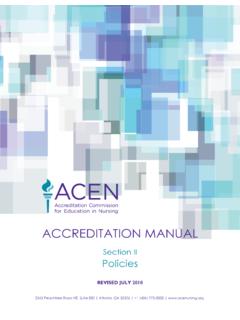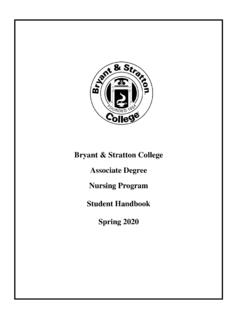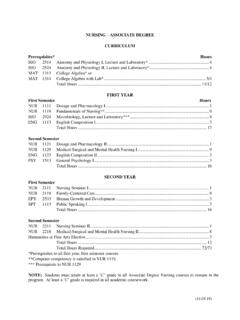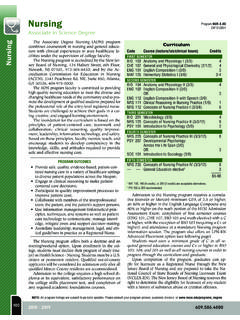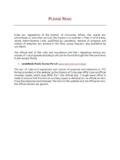Transcription of STANDARD 1 - acenursing.net
1 ACEN 2017 standards AND CRITERIA associate STANDARD 1 Mission and Administrative Capacity The mission of the nursing education unit reflects the governing organization s core values and is congruent with its mission/goals. The governing organization and program have administrative capacity resulting in effective delivery of the nursing program and achievement of identified program outcomes. The mission and philosophy of the nursing education unit are congruent with the core values, mission, and goals of the governing organization. The governing organization and nursing education unit ensure representation of the nurse administrator and nursing faculty in governance activities; opportunities exist for student representation in governance activities.
2 The assessment of end-of-program student learning outcomes and program outcomes is shared with communities of interest, and the communities of interest have input into program processes and decision-making. Partnerships that exist promote excellence in nursing education, enhance the profession, and benefit the community. The nursing education unit is administered by a nurse who holds a graduate degree with a major in nursing . The nurse administrator is experientially qualified, meets governing organization and state requirements, and is oriented and mentored to the role. When present, nursing program coordinators and/or faculty who assist with program administration are academically and experientially qualified.
3 The nurse administrator has authority and responsibility for the development and administration of the program and has sufficient time and resources to fulfill the role responsibilities. The nurse administrator has the authority to prepare and administer the program budget with faculty input. Policies for nursing faculty and staff are comprehensive, provide for the welfare of faculty and staff, and are consistent with those of the governing organization; differences are justified by the purpose and outcomes of the nursing program. Distance education, when utilized, is congruent with the mission of the governing organization and the mission/philosophy of the nursing education unit. associate - 1 -ACEN 2017 standards AND CRITERIA associate STANDARD 2 Faculty and Staff Qualified and credentialed faculty are sufficient in number to ensure the achievement of the end-of-program student learning outcomes and program outcomes.
4 Sufficient and qualified staff are available to support the nursing program. Full- and part-time faculty include those individuals teaching and/or evaluating students in didactic, clinical, and/or laboratory settings. Full-time nursing faculty hold educational qualifications and experience as required by the governing organization, the state, and the governing organization's accrediting agency, and are qualified to teach the assigned nursing courses. Part-time nursing faculty hold educational qualifications and experience as required by the governing organization, the state, and the governing organization's accrediting agency, and are qualified to teach the assigned nursing courses. Non-nurse faculty teaching nursing courses hold educational qualifications and experience as required by the governing organization, the state, and the governing organization's accrediting agency, and are qualified to teach the assigned nursing courses.
5 Preceptors, when utilized, are academically and experientially qualified, oriented, mentored, and monitored, and have clearly documented roles and responsibilities. The number of full-time faculty is sufficient to ensure that the end-of-program student learning outcomes and program outcomes are achieved. Faculty (full- and part-time) maintain expertise in their areas of responsibility, and their performance reflects scholarship and evidence-based teaching and clinical practices. The number and qualifications of staff within the nursing education unit are sufficient to support the nursing program. Faculty (full- and part-time) are oriented and mentored in their areas of responsibility. Faculty (full- and part-time) performance is regularly evaluated in accordance with the governing organization s policy/procedures, and demonstrates effectiveness in assigned area(s) of responsibility.
6 Faculty (full- and part-time) engage in ongoing development and receive support for instructional and distance technologies. associate - 2 -ACEN 2017 standards AND CRITERIA associate STANDARD 3 Students Student policies and services support the achievement of the end-of-program student learning outcomes and program outcomes of the nursing program. Policies for nursing students are congruent with those of the governing organization as well as the state, when applicable, and are publicly accessible, non-discriminatory, and consistently applied; differences are justified by the end-of-program student learning outcomes and program outcomes. Public information is accurate, clear, consistent, and accessible, including the program s accreditation status and the ACEN contact information.
7 Changes in policies, procedures, and program information are clearly and consistently communicated to students in a timely manner. Student services are commensurate with the needs of nursing students, including those receiving instruction using alternative methods of delivery. Student educational records are in compliance with the policies of the governing organization and state and federal guidelines. Compliance with the Higher Education Reauthorization Act Title IV eligibility and certification requirements is maintained, including default rates and the results of financial or compliance audits. A written, comprehensive student loan repayment program addressing student loan information, counseling, monitoring, and cooperation with lenders is available.
8 Students are informed of their ethical responsibilities regarding financial assistance. Financial aid records are in compliance with the policies of the governing organization, state, and federal guidelines. Records reflect that program complaints and grievances receive due process and include evidence of resolution. Orientation to technology is provided, and technological support is available to students. Information related to technology requirements and policies specific to distance education are accurate, clear, consistent, and accessible. associate - 3 -ACEN 2017 standards AND CRITERIA associate STANDARD 4 Curriculum The curriculum supports the achievement of the end-of-program student learning outcomes and program outcomes and is consistent with safe practice in contemporary healthcare environments.
9 Consistent with contemporary practice, the curriculum incorporates established professional nursing standards , guidelines, and competencies and has clearly articulated end-of-program student learning outcomes. The end-of-program student learning outcomes are used to organize the curriculum, guide the delivery of instruction, and direct learning activities. The curriculum is developed by the faculty and regularly reviewed to ensure integrity, rigor, and currency. The curriculum includes general education courses that enhance professional nursing knowledge and practice. The curriculum includes cultural, ethnic, and socially diverse concepts and may also include experiences from regional, national, or global perspectives.
10 The curriculum and instructional processes reflect educational theory, interprofessional collaboration, research, and current standards of practice. Evaluation methodologies are varied, reflect established professional and practice competencies, and measure the achievement of the end-of-program student learning outcomes. The total number of credit/quarter hours required to complete the defined nursing program of study is congruent with the attainment of the identified end-of-program student learning outcomes and program outcomes, and is consistent with the policies of the governing organization, the state, and the governing organization's accrediting agency. Student clinical experiences and practice learning environments are evidence-based; reflect contemporary practice and nationally established patient health and safety goals; and support the achievement of the end-of-program student learning outcomes.
